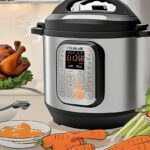Navigating the complex world of cookware, you’ve likely encountered the pesky problem of pan-warping. A seemingly innocuous issue, a warped pan can sabotage your meal preparations, hinder consistent heat distribution, and even pose safety risks.
As kitchen enthusiasts, we often overlook the science behind our cooking tools, but understanding how our pans behave under different conditions is essential.
That’s why we’re diving deep into the cause, impact, and solutions of pan-warping – to ensure your culinary journey is as smooth as your flat-bottomed skillet ought to be.
Factors Leading to Pan Warping:
A. Types of Cookware Prone to Warping
Different types of cookware have varied susceptibilities to warping. In general, thin, lightweight pans, especially those made from aluminum, are more prone to warping due to their lower heat capacity.
Conversely, thicker, heavier pans made from materials like cast iron or stainless steel with an aluminum or copper core tend to be more resistant due to their ability to absorb and distribute heat more evenly.
B. Role of Heat Sources and Cooking Techniques in Pan Warping
The heat source and cooking technique can significantly influence pan warping. High heat, especially when concentrated in one area, can cause a pan to warp. Rapid heating techniques, like searing, can make a pan more susceptible to warping.
Moreover, using a pan on a burner larger than the pan’s bottom can lead to uneven heating and subsequent warping.
C. Effect of Sudden Temperature Changes on Pans
Sudden temperature changes are another critical factor in pan-warping. Subjecting a hot pan to a cold environment, such as rinsing a heated pan under cold water, leads to a rapid contraction of the pan’s material, causing it to warp.
The same effect can occur when a cold pan is exposed to high heat rapidly. This thermal shock can deform the structure of the pan, leading to warping.
Impact of Pan Warping on Cooking and Kitchen Safety:
A. Impact on Heat Distribution and Cooking Consistency
A warped pan can lead to uneven cooking due to inconsistent heat distribution. Because the pan’s surface is no longer flat, some parts of the pan may receive more heat than others. This means that food placed in different areas of the pan may cook at different rates, potentially resulting in undercooked or overcooked dishes.
B. Potential Safety Hazards of Using Warped Pans
Using warped pans can also pose safety risks. When a pan is not flat, it may wobble or tilt on the stovetop, making it unstable. This instability can lead to spills and potential burns. In the worst-case scenario, it could even tip over entirely, causing a dangerous mess of hot food and potentially leading to injuries.
C. Impact on Stovetops
A warped pan can also cause damage to your stovetop. A warped pan can scratch or crack the surface if you’re using a flat-top electric or induction stove.
On gas stoves, uneven heat distribution can lead to inefficient energy use and potentially damage the burners. In all cases, the longevity and functionality of your stovetop may be compromised when using warped pans.
Identifying a Warped Pan:
A. How to Spot a Warped Pan
Identifying a warped pan requires a keen eye and a simple test. Place the pan on a flat surface. If it wobbles, it’s likely warped. Alternatively, you can pour a small amount of water into the pan.
If the water collects in one area rather than spreading evenly, this indicates warping. Visually inspecting the pan can also be helpful. If the bottom of the pan isn’t flat or there are any noticeable bulges, these are signs of warping.
B. Types of Pan Warping
There are different types of pan-warping to be aware of. Spin warping results in a pan that spins or rotates freely on a flat surface. Dome warping creates a raised center in the pan so that the sides are lower than the middle.
Saddle warping causes the sides of the pan to rise, creating a dip in the middle. Understanding these types of warping can help you more accurately identify and address issues with your pans.
How to Prevent Pan Warping?
1. Careful Handling of Cookware
One of the simplest ways to prevent pan warping is to carefully handle your cookware. This means avoiding rapid temperature changes by not placing a hot pan under cold water and heating your pan gradually instead of preheating it on high.
2. Quality Cookware Materials
Investing in high-quality cookware made from materials resistant to warping, like cast iron or heavy-gauge stainless steel with an aluminum or copper core, can help prevent this problem. These materials can better withstand the stress of high heat and rapid temperature changes.
3. Proper Cooking Methods and Heat Management
Proper cooking methods and managing heat appropriately can also help prevent pan-warping. This includes using a burner that matches the size of your pan, heating your pan slowly, and avoiding extremely high heat unless necessary. Letting your pan cool down naturally after cooking is also important instead of speeding up the process by placing it under cold water.
 Conclusion:
Conclusion:
In our culinary adventures, keeping our cookware in top-notch condition is as vital as the quality of our ingredients. Warped pans may seem minor, but they can drastically impact our cooking outcomes and pose safety hazards.
By understanding the causes of pan-warping and employing preventive measures, we can prolong the lifespan of our beloved pans, ensuring consistently delicious meals.
Whether it’s opting for quality materials, managing heat wisely, or treating our pans with care, it’s clear that mindful kitchen practices are key to preventing pan-warping and preserving our culinary arsenal.
- What size pan is one and a half (1.5) quarts? - June 8, 2023
- Le Creuset saucepan sizes: Choosing the Perfect Pan - June 8, 2023
- Blue diamond pan instructions: Step-by-Step Guide - June 8, 2023






